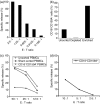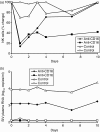Use of an anti-CD16 antibody for in vivo depletion of natural killer cells in rhesus macaques
- PMID: 18201184
- PMCID: PMC2566626
- DOI: 10.1111/j.1365-2567.2007.02757.x
Use of an anti-CD16 antibody for in vivo depletion of natural killer cells in rhesus macaques
Abstract
Non-human primates serve as key animal models for a variety of viral infections. To evaluate the contribution of natural killer (NK) cells to the immune-mediated control of these viruses in macaque monkeys, we have described a method for depleting NK cells in vivo by administration of anti-human CD16 mouse monoclonal antibody. Using a fluorometric NK-cell cytotoxicity assay, we show that most NK-cell cytotoxicity in rhesus monkey peripheral blood mononuclear cells resides in the CD16(+) and/or CD159A(+) subset of lymphocytes. The anti-human CD16 antibody, 3G8, binds to subsets of rhesus monkey lymphocytes and monocytes but not to neutrophils. Intravenous administration of 10-50 mg/kg of 3G8 to normal rhesus monkeys resulted in anti-CD16 antibody persistence in the plasma for 1-3 weeks. This treatment also depleted 80-90% of CD3(-) CD159A(+) lymphocytes, putative NK cells, from blood for at least 1 week and was associated with the loss of NK-cell cytotoxicity when evaluated by in vitro assays. Using this method, transient depletion of NK cells from two rhesus monkeys chronically infected with simian immunodeficiency virus failed to cause changes in virus replication. These studies describe a non-human primate model for in vivo NK-cell depletion and suggest a limited role for cytotoxic CD16(+) NK cells in controlling AIDS virus replication during chronic infection.
Figures






References
-
- Biron CA, Byron KS, Sullivan JL. Severe herpesvirus infections in an adolescent without natural killer cells. N Engl J Med. 1989;320:1731–5. - PubMed
-
- Orange JS. Human natural killer cell deficiencies and susceptibility to infection. Microbe Infect. 2002;4:1545–58. - PubMed
-
- Kasai M, Iwamori M, Nagai Y, Okumura K, Tada T. A glycolipid on the surface of mouse natural killer cells. Eur J Immunol. 1980;10:175–80. - PubMed
-
- Lian RH, Kumar V. Murine natural killer cell progenitors and their requirements for development. Semin Immunol. 2002;14:453–60. - PubMed
Publication types
MeSH terms
Substances
Grants and funding
LinkOut - more resources
Full Text Sources
Other Literature Sources

